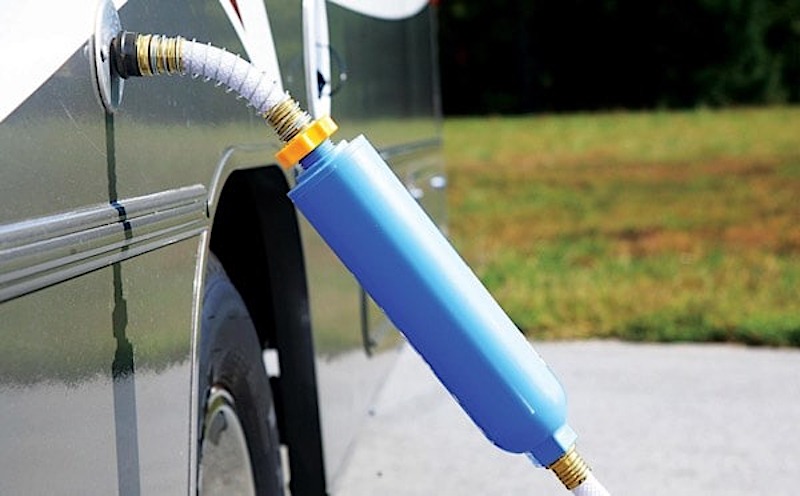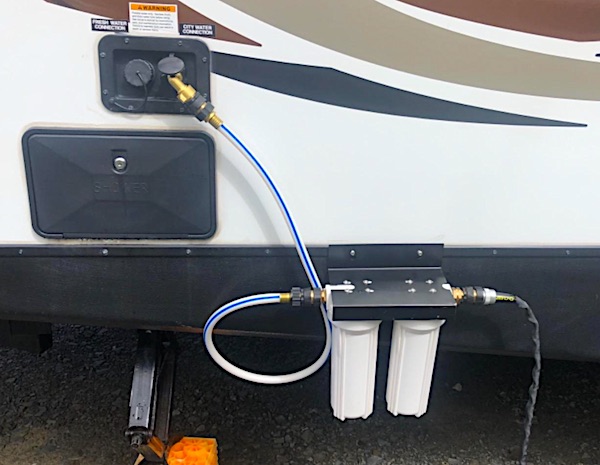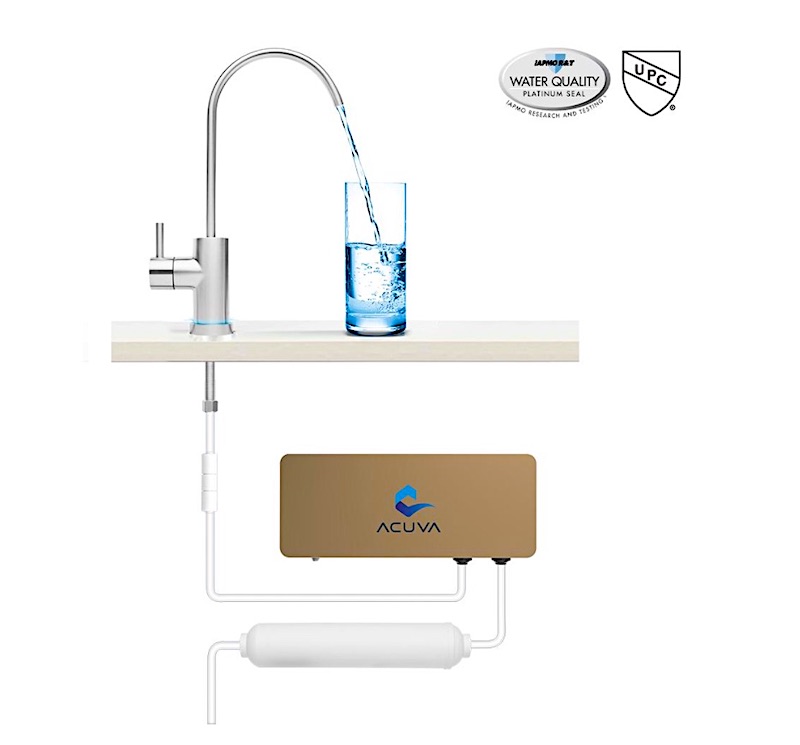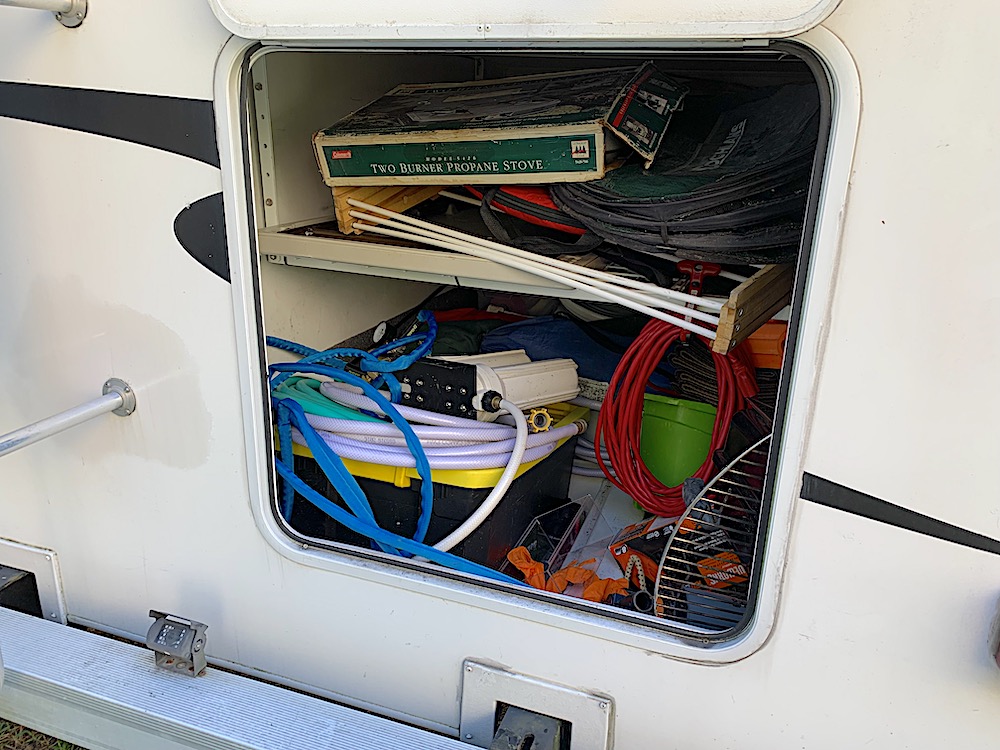Thanks for your support! If you make a purchase using our links in this article, we may make a commission. And, as an Amazon Associate, I earn from qualifying purchases. See the full disclosure here.
Ever wonder how to store an RV water filter between trips? We’ve seen this question pop up many times in our Facebook Group so we decided to write an article all about it.
The quick answer is the best way to store your RV water filter between trips is to drain the filter and the hose completely. Then remove the filter, place it in a zip lock storage bag, and store them in the fridge. Then connect the hose ends to prevent water from dripping into your storage compartment.
No matter if you’re a weekender, part-timer, snowbird, or live the full-time RV lifestyle, storing an RV water filter between trips can save you money without the worry of your cartridge turning into a 5th-grade science project.
You don’t need to buy a water purification system that rivals the International Space Station; simply following some easy RV wisdom will let you reuse your RV water filter for months.
In this discussion, you’ll learn how best to store external RV plumbing equipment to extend usage time for your water filter and hose. Then, we’ll also talk about how often you should replace your filter cartridge or your inline filter.
When it comes to optimizing the longevity of your RV water filter, consider investing in a high-quality filter from All Filters. Their reliable products ensure effective water purification for months, allowing you to follow practical RV wisdom for prolonged use without the need for an overly complex water purification system.
Finally, you’ll learn about an incredible UV-LED water purification system that’ll take your water purity to the next level.
How to Store an In-Line Water Filter When Not in Use

To store an in-line water filter when not in use, drain it first and then put it into a zip-top bag (to use TSA’s vernacular), and throw it in the fridge. Be careful not to hit the eggs; that could get messy.
After you break camp, let the excess water drain out. Then, use the plastic caps that came with the filter to close off both ends to seal it up. If you can’t refrigerate the filter, keep it in the dark to prevent bacteria growth. Some will use a three-foot water hose connecting to both ends of the filter.
One idea that’s been floating around the RV Community for decades is painting your RV inline water filter. Different versions claim that one color is better because it blocks sun exposure.
There’s not enough evidence to support this idea, but those that use fluorescent paint or tape make it easier to avoid tripping hazards.
How to Store a Two-Stage Water Filter When Not in Use

Storing a two-stage water filter when not in use is the same as an inline RV water filter. Place it in a zip-top bag and refrigerate. Putting an RV water filter in the freezer will destroy it. As the water turns into ice, the crystals rip the paper-like material. Ice also damages the integrity of the carbon material of inline filters, so avoid the freezer.
How to Store Your Fresh Water Hose When Not in Use
When not in use, storing your freshwater hose should be more complicated than coiling it up and tossing it in your exterior bay. The difference between an RV water hose and a garden hose has to do with the construction of the water lines. A garden hose’s purpose is for outdoor use only and has a liner that prevents leaks.
RV water hoses have a special lining for human consumption, bathing, and other uses. The liner prevents ground pesticides and other chemicals from leaching through the hose. That’s why many prefer to place the inline RV water filter on the campground water hookup; only clean water flows through the hose.
Here are some travel trailer water hose storage ideas to keep it safe from contamination:
- As you coil it on one end, leave the other end loose on a clean surface (like an RV jack pad) to thoroughly drain the hose.
- Rinse off the brass ends and screw on RV water hose caps or screw the male end to the female end of the hose. It also prevents dirt, bugs, or other things from getting inside.
- Store your freshwater hose in a sealable storage bin to prevent water seepage from ruining your gear or RV.
RV water hoses last an average of 5-10 years. When running through your preventive maintenance checklist, it’s a good idea to run water through it at home, checking for leaks along the line and the brass fittings.
Leaks in the brass connections may be simple by replacing the rubber gasket. Also, make sure the exterior is clean and contaminant growth particles aren’t coming from the hose itself (use an inline water filter on the spigot to prevent anything from the water pipes).
Some use a highly diluted solution of bleach and water (about a ½ teaspoon per 5 gallons) to soak and disinfect their water hose. It may seem like a weak mixture, but you don’t want the bleach to destroy the hose’s liner. When in doubt, RV water hoses cost around $20 to replace. When it comes to drinking water, your mantra should be “new is better than damaged.”
How Long Will an RV Water Filter Last?
The time length an RV water filter will last ranges from three to six months. It depends on the amount of usage, storage conditions, and other factors. For example, full-timers will run through a value brand inline RV water filter within three months, while a weekender can stretch out the same filter up to six months using the proper storage techniques.
3-stage RV water filter system cartridges may last a little longer if you clean them correctly. These filters are fragile, so using the wrong cleaner or the wrong dilution ratio can damage them.
Do RV Water Filters Remove Bacteria?
The best RV water filters don’t remove bacteria. Water filters remove heavy metals, chemicals, dirt, sand, and other contaminants.
Government agencies that monitor water quality have standards that utility companies must adhere to for microorganism counts. They use chemical and other treatment techniques to minimize those counts.
Natural wells use commercial level filtration systems to reduce bacteria and viral counts.
What’s the Best Way to Ensure My RV Drinking Water is Safe?
The best way to ensure your RV drinking water is safe is to treat your RV’s drinking water with a UV-LED water purifier. Industrial versions have existed for years, but companies like Acuva Technologies (AcuvaTech), have shrunk the technology and made them affordable for home and RV use.
Installing one of their UV-LED Water Purifiers disinfects 99.9999% of all microorganisms in your post-filtered RV water. Off-grid RVers will enjoy the energy efficiency of the LED system, budget-conscious campers will love the long life and affordability.
You can read more about how the Acuvatech UV-LED RV water purification system works in our feature article.

How Many Uses Can I Get Out of a Filter Cartridge Only Using it on Weekends? (cartridge inside multi-stage filters)
Ideally, weekenders can get six months of use out of their filter cartridge if they correctly follow the RV water filter storage procedures. That’s 26 weekends in six months (52 weeks in a year, divided by two).
Yet, we don’t live in the vacuum-like conditions of a laboratory. Review apps and trip planners like RV Trip Wizard and The Dyrt do a great job giving you the real story behind every campground; you never know what your campsite’s water conditions are until you open the water hookup.
We recommend changing your multi-stage RV water filter cartridges, as a weekender, around the five-month mark to be safe. You want to protect your RV’s plumbing from contamination as best possible. The new filter cartridges for $20-$30 are a lot cheaper than replacing the damaged PEX plumbing throughout your RV.
What’s a Good Replacement Cartridge to Use?
All Filters
When it comes to optimizing the longevity of your RV water filter, consider investing in a high-quality filter from All Filters. Their reliable products ensure effective water purification for months, allowing you to follow practical RV wisdom for prolonged use without the need for an overly complex water purification system.
Camco
Camco RV water filters are found almost everywhere. You’ll find their blue TastePure value brand at Walmart in the RV water filter aisle. Camco also offers the EVO RV canister water filter system and white Hydro Life water filter brand.
Clear2O
Clear2O RV water filters come in a green inline filter with a Dirtguard Sediment Pre-Filter that fits over the inline device. Their canister water filter system with a bracket can be mounted in your utility bay or sit outside your coach. This brand offers a countertop water filtration system with a spout that installs without tools.
Beech Lane 2 Stage Filter
Beech Lane is an RV essential accessories company that also offers a dual water filtration system. The filters come in 5 and 0.5 microns for maximum purity. The company offers a 100% guarantee and a lifetime warranty.
Culligan
Culligan made its name in home and commercial water delivery and filtration. You can find their white inline, cartridge, and drinking water filtration systems on Amazon at competitive prices.
What’s the Best RV Water Filter for 2021?
The best RV water filter for 2021 boils down to personal choice. You’ll find loyal fans of each brand around campfires around the country. If you’re not sure, start by trying the inline RV water filters first. They’re the least expensive, have great filtration properties, and are easier to dispose of than the canister versions.
We use the Beech Lane 2 Stage Filter on our RV and we are very happy with it. Most other 2 stage filters cost in the neighborhood of $250 but the Beech lane filter is well under $100.
The best way to store your RV water filter between trips is to drain the filter and the hose completely. Then remove the filters, place them in a zip lock storage bag and store them in the fridge. Then connect the hose ends to prevent water from dripping into your storage compartment.
Related Reading:
1. How to Setup Your RV Campsite for Beginners Water, Sewer, Electric, and Gear
2. Why UV Water Purification Systems for RVs are Vital
3. 6 Best RV Water Pressure Regulators to Prevent RV Plumbing Leaks
4. How to Keep an RV Water Hose from Freezing
5. How Much Does an RV Water Heater Cost?
To learn more about your RV water system and other essential systems of your RV, check out the RVBlogger Website. You’ll find the best tips, trends, and topics you need to know to make your RV experience that much better. You can even see how we do it on our Instagram page.
For peer advice, join the conversation on our Facebook page, RV Camping for Newbies. Thousands of our RVBlogger friends are there to offer their advice on how they store their water filters, hoses, and which brands they prefer.
Every Sunday night, we walk through the latest RV models by topic or other relevant features on the RVBlogger YouTube Channel. You’ll be able to see for yourself the size of the kitchen sink, bathroom features, and Mike even measures the headspace in the shower with his trusty tape measure.
Of course, don’t forget to sign up for your free copy of our digital magazine, RV Camping Magazine. Learn how to maintain and repair your RV from the National RV Training Academy. You’ll see how vintage RV restorers and current model remodelers take their coaches to the next level.
We also feature interviews with famous RV influencers, current trends, delicious recipes for RV kitchens, and more. In fact, our September issue discusses the Acuvatech UV-LED water purification system in further detail. All of our magazine subscribers have free access to our back issues!
So, from Mike and Susan, thanks for reading, and we’ll see you next time!

